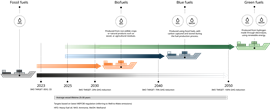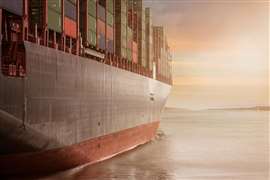Report: Policy can drive cost parity for sustainable shipping fuels
21 March 2024
Wärtsilä analysis shows EU ETS and FuelEU Maritime will close price gap with fossil fuels
 The report provides a roadmap for the future of sustainable fuels, identifying how the industry can more rapidly and affordably scale these fuels and achieve full decarbonization by mid-century – within the lifetime of just a single vessel. (Source: Wärtsilä)
The report provides a roadmap for the future of sustainable fuels, identifying how the industry can more rapidly and affordably scale these fuels and achieve full decarbonization by mid-century – within the lifetime of just a single vessel. (Source: Wärtsilä)
Sustainable shipping fuels could reach cost parity with fossil fuels as early as 2035 with the help of decisive emissions policy such as carbon taxes and emissions limits, according to “Sustainable fuels for shipping by 2050 – the 3 key elements of success”, a new report launched by technology group Wärtsilä.
The report indicates that the EU Emissions Trading Scheme (ETS) and FuelEU Maritime Initiative (FEUM), which come into effect from January 1, 2024, and 2025, respectively, will see the cost of using fossil fuels more than double by 2030, but by 2035 will close the price gap (for European fleets) between fossil fuels and sustainable fuels for the first time.
The shipping industry, which transports 80% of world trade, currently emits 2% of global emissions, equivalent to the annual emissions of Japan, Wärtsilä indicated. Without action, this could increase by more than 45% by 2050.
In 2023, the International Maritime Organization (IMO) set a target of achieving net-zero emissions by 2050. Existing decarbonization solutions, such as fuel efficiency measures, could cut up to 27% of emissions, with sustainable fuels a critical step in eliminating the remaining 73%, the report stated – but radical action is needed to scale them.
 Photo by Pixabay
Photo by Pixabay
“Achieving net zero in shipping by 2050 will require all the tools in the toolbox, including sustainable fuels. As an industry, we must focus on coordinating action across policymakers, industry and individual operators to bring about the broad system change required to quickly and affordably produce a mix of sustainable fuels,” said Roger Holm, president of Wärtsilä Marine & executive vice president at Wärtsilä Corporation. “Policy in Europe is showing just how impactful action at the international level can be, closing the cost gap between fossil- and low-carbon fuels for the first time.”
In its report, Wärtsilä presents new modeling that shows a timeline of which fuels are likely to become widely available on a global scale, when and at what cost. To accelerate this timeline, the report argues that decisive policy implementation, industry collaboration and individual operator action must coalesce to scale the production of these fuels.
Wärtsilä’s modelling shows sustainable fuels will be 3-5 times more expensive than today’s fossil fuels in 2030. The report argues that policy is key to closing that price gap, adding that policymakers should:
- Maximize certainty by setting an internationally agreed science-based pathway for phasing out fossil fuels from the marine sector, in line with IMO targets.
- Boosting cost competitiveness by adopting a global industry standard for marine fuel carbon pricing.
- Increase global collaboration between governments on the innovation and infrastructure necessary to deliver sustainable fuels at scale worldwide.
The sector must also collaborate with stakeholders from inside and outside shipping. The report calls on industry to:
- Initiate sector-wide procurement agreements to pool demand, and buying power, from multiple shipping operators.
- Collaborate with other sectors, including convening with leaders in aviation, heavy transport and industry to establish a globally recognized framework for the production and allocation of sustainable fuels.
- Establish an industry-wide knowledge hub for the purpose of sharing expertise, skills and insights.
Individual action is also required, the report states, in the form of investment to save fuel costs. According to Wärtsilä, every euro an operator saves fuel costs at today’s prices could be worth 3-5 times that by 2030. The company went on to note that Carnival Corporation has achieved a 5% to 10% efficiency gain through its Service Power Upgrade Program, which could cut fleetwide fuel costs by as much as $750 million per year in 2030.
However, Wärtsilä believes fleets of all sizes can benefit. “If there is one take-away from our report, it is that smaller operators need not feel powerless. They have a major role in accelerating towards net-zero emissions shipping,” Holm said. “Taking steps to improve fuel efficiency and invest in fuel flexibility can deliver immediate returns, reducing both emissions and operating costs. But action must be swift – we have the lifecycle of just a single vessel to get this right.”
Such action includes investing in fuel flexibility, which Wärtsilä said is the most financially viable way to avoid the risk of stranded assets. The company pointed out that it has been developing multiple fuel options, including launching what it said is the first commercially available four-stroke engine for ammonia fuel.
|
STAY CONNECTED




Receive the information you need when you need it through our world-leading magazines, newsletters and daily briefings.
POWER SOURCING GUIDE
The trusted reference and buyer’s guide for 83 years
The original “desktop search engine,” guiding nearly 10,000 users in more than 90 countries it is the primary reference for specifications and details on all the components that go into engine systems.
Visit Now
CONNECT WITH THE TEAM










